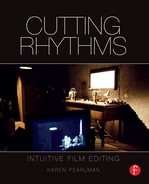There have been a lot of changes to industry, technology and audiences since the first edition of Cutting Rhythms, Shaping the Film Edit. Forms, formats and distribution have changed. Editing gear has changed. Audience access and viewing patterns have changed. All of these will continue to change, and these changes all impact on editing.
Change is not new, though. It has been a constant since the beginning of film. Even the word “film” doesn’t mean what it used to. It used to mean a celluloid substance, now it is a generic word for a screen story experience. A filmmaker rarely works with film. She makes screen stories. But she is still a filmmaker. So, rather than changing the book to address particular changes to industry and technologies, which will change again before you read this, this new edition is looking at change as part of what we do.
Editing is change. It is transformation. Editing changes two shots into a juxtaposition. It changes movement into rhythm. Editing is the skill that transforms any mass of material into a coherent story.
If there is a new theme to this second edition it is this: editing is a transferable skill. It doesn’t just work on celluloid, movies, and TV shows. Editors can transfer their abilities to new formats and platforms. We can apply our “editing thinking” to words, images, sounds, games, apps, series, events, experiences, and things as yet unknown or unnamed.
The new title reflects this theme. It used to be Cutting Rhythms: Shaping the Film Edit. Now it is Cutting Rhythms: Intuitive Film Editing. Cutting rhythms is what we do. Editing intuition is what we develop and take with us across forms, formats, media, and technologies as they and their audiences change.
